Follow the steps below on how to import Office 365 PST files step by step:
1. Assign Mailbox Import Export role
You must be assigned the Mailbox Import Export role in Exchange Online to create import jobs in the Microsoft Purview compliance portal and import PST files to user mailboxes. By default, this role isn’t assigned to any role group in Exchange Online.
Assign Mailbox Import Export role in Exchange Online to create import jobs in the Microsoft Purview compliance portal and import PST files to user mailboxes:
- Sign in to Exchange Admin Center.
- Expand Roles and click on Admin roles.
- Select Organization Management.

- Click on the tab Permissions.
- Select Mailbox Import Export role.
- Click Save.
Note: It can take up to 24 hours before the change applies. But, most of the time it will work within 1 hour.
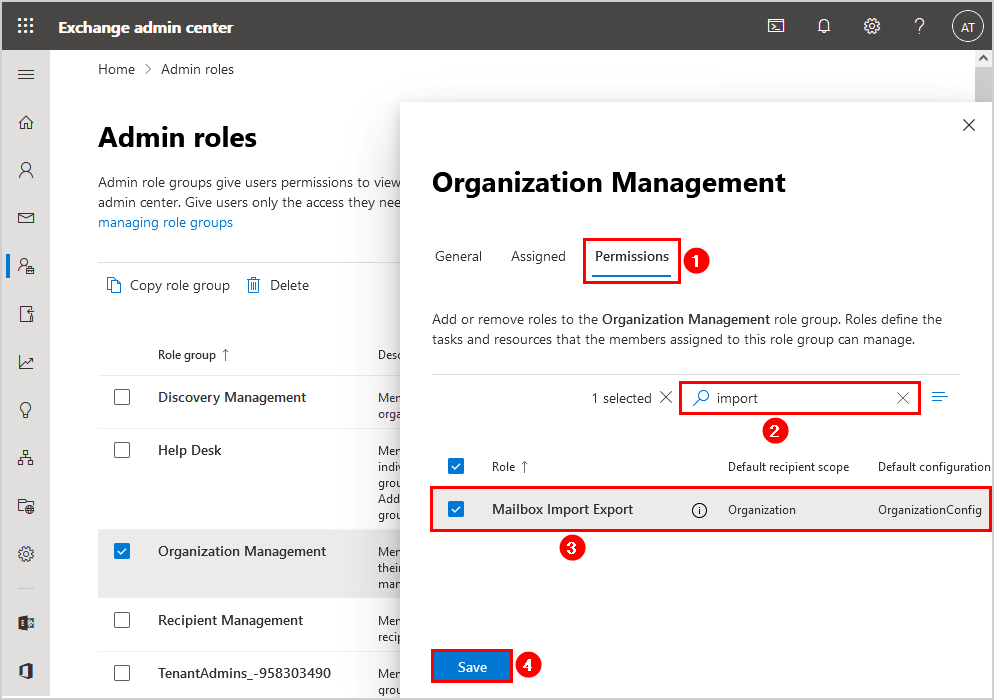
Suppose you get the below error after clicking on Save:
We couldn’t save your changes. Please try again.
An excellent alternative way to add the Mailbox Import Export role is with PowerShell.
Connect to Exchange Online PowerShell and run the New-ManagementRoleAssignment cmdlet.
PS C:\> New-ManagementRoleAssignment -Role "Mailbox Import Export" -SecurityGroup "Organization Management" -Name "Import Export Org Management" Name Role RoleAssigneeName RoleAssigneeType AssignmentMethod EffectiveUserName ---- ---- ---------------- ---------------- ---------------- ----------------- Import Export Org Management Mailbox Import... Organization M... RoleGroup Direct
Note: If you get a dehydration error, read the article Tenant organization is dehydrated.
2. Create PST import job
To create a PST import job in Microsoft Purview compliance portal, follow these steps:
- Sign in to Microsoft Purview compliance portal.
- Expand Data lifecycle management and click on Microsoft 365.
- Choose Import.
- Click on New Import Job.

If you don’t see a New import job, it means that you have to wait before the change in the previous steps applies.

- Give the import job a name. Click Next.

- Select Upload your data. Click Next.

- Click on Show network upload SAS URL.

- Click on Copy to clipboard to copy the SAS URL. You will need the SAS URL in the next step.

In the next step, you will upload the PST files to Office 365 with AzCopy command-line tool.
Note: Don’t cancel the import job because you need to return to this window and finish the import job. If you cancel the import job, you have to go through the steps again.
3. Upload PST files to Office 365
- Download AzCopy (Microsoft), and place it in the C:\Temp folder. AzCopy V10 is just an executable file, so there’s nothing to install.
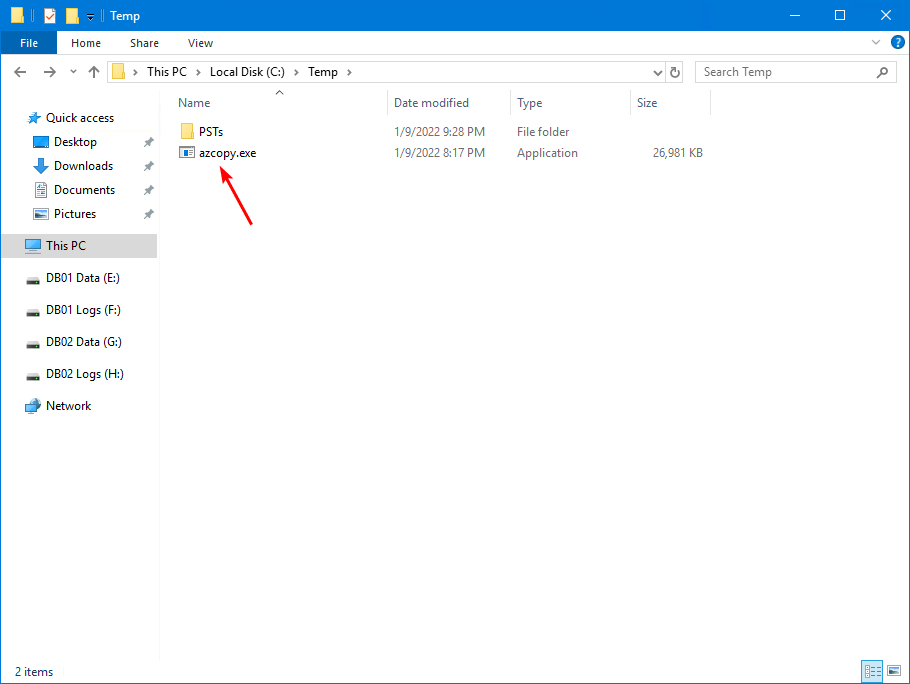
- Check the location of the PST files.
You can use the source directory on the share (\\yourserver\PSTs) or local drive (C:\PSTs). In our example, the PST file is on the local drive path C:\Temp\PSTs.
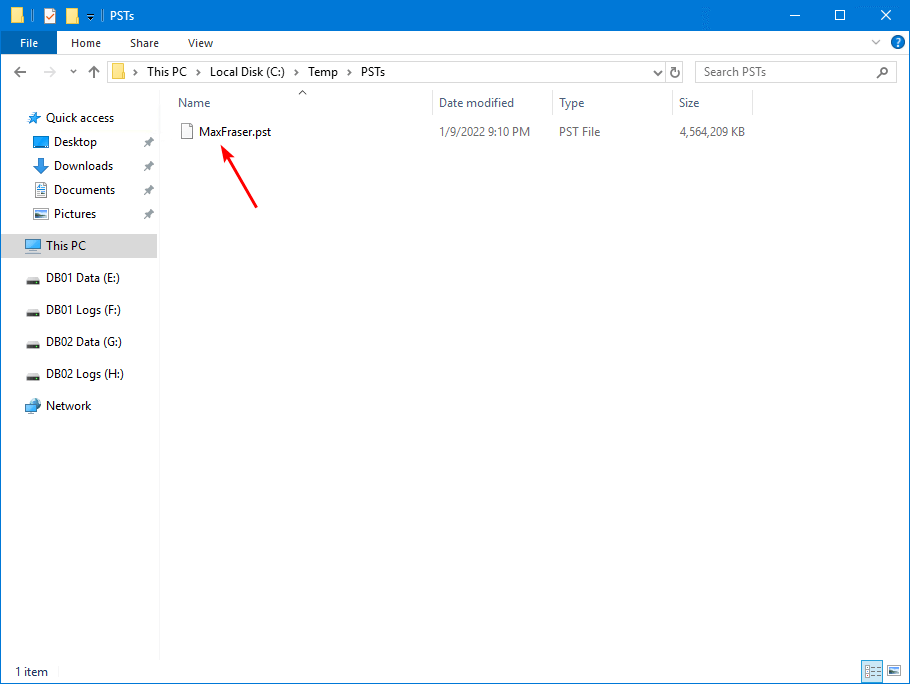
- Start Command Prompt as administrator.
- Change the directory to C:\Temp\.
- Paste the SAS URL you copied in the previous step in the command.
- Run the command to copy the PST file to Azure.
C:\>cd C:\Temp\ C:\Temp>azcopy.exe copy "C:\Temp\PSTs" "https://e5c2666294514f92b02da36.blob.core.windows.net/ingestiondata?sv=2015-04-05&sr=c&si=IngestionSasForAzCopy202201091916203434&sig=KF5CRE4YM65BLHgYtw%2BY0knNc%2ByNB%2B8w7aAfRXt8sT8%3D&se=2022-02-08T19%3A16%3A22Z" --recursive
- The output will show like this.
INFO: Scanning... INFO: Any empty folders will not be processed, because source and/or destination doesn't have full folder support Job 37cf8d63-d431-e143-78c2-e3a9b85d0d7e has started Log file is located at: C:\Users\administrator.EXOIP\.azcopy\37cf8d63-d431-e143-78c2-e3a9b85d0d7e.log INFO: Could not read destination length. If the destination is write-only, use --check-length=false on the command line. 100.0 %, 1 Done, 0 Failed, 0 Pending, 0 Skipped, 1 Total, 2-sec Throughput (Mb/s): 26.7263 Job 37cf8d63-d431-e143-78c2-e3a9b85d0d7e summary Elapsed Time (Minutes): 20.6073 Number of File Transfers: 1 Number of Folder Property Transfers: 0 Total Number of Transfers: 1 Number of Transfers Completed: 1 Number of Transfers Failed: 0 Number of Transfers Skipped: 0 TotalBytesTransferred: 4673750016 Final Job Status: Completed
Note: You can’t use the Azure Storage Explorer to upload or modify PST files. The only supported method for importing PST files is to use AzCopy. Also, you can’t delete PST files that you’ve uploaded to the Azure blob. If you try to delete a PST file, you’ll receive an error about not having the required permissions.
4. View PST files uploaded to Office 365
To install the Azure Storage Explorer and connect to your Azure Storage area, follow these steps:
- Download and install the Microsoft Azure Storage Explorer tool.

- Start Microsoft Azure Storage Explorer.
- Right-click Storage Accounts.
- Click on Connect to Azure Storage.

- Click on Blob container.

- Select Shared access signature URL (SAS). Click Next.

- Insert Display name.
- Paste the Blob container SAS URL that you obtained from the previous step.
- Click Next.

- Click Connect.

- You will see the PSTs folder and the PST file.

Note: All PST files are automatically deleted from your Azure storage area. If there are no import jobs in progress, then all PST files in the ingestiondata container are deleted 30 days after the most recent import job was created.
Now that you verified that the PST files are in the Azure storage, proceed to the next step.
5. Create PST import mapping file
- Download a copy of the PST import mapping file (direct) or (Microsoft).
- Start Microsoft Excel.
- Go to the Excel advanced options and change the below options:
- Uncheck the use system operators
- Set Decimal seperator to period (.)
- Set Thousands seperator to comma (,)
Important: Uploading the CSV file in the next step will show an error after validating the mapping file if you don’t set the system operators correctly.
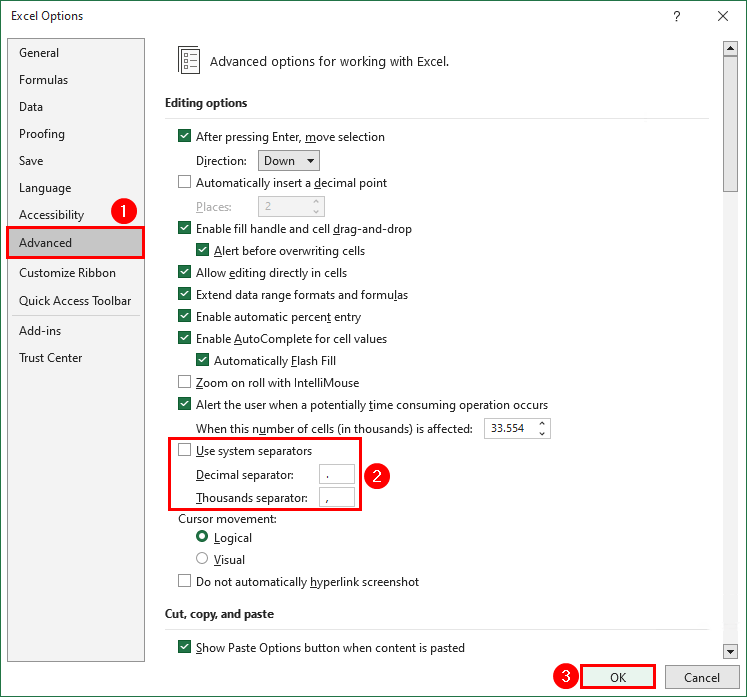
- Open the CSV file with Microsoft Excel and edit the values.
Pay close attention to the values and what you need to set:
- Workload: Specifies the service that data will be imported to. To import PST files to user mailboxes, use Exchange.
- FilePath: Specifies the folder location in the Azure Storage location that you uploaded the PST files to.
- Name: Specifies the name of the PST file that will be imported to the user mailbox. The value for this parameter is case-sensitive.
- Mailbox: Specifies the email address of the mailbox that the PST file will be imported to.
- IsArchive: Specifies whether to import the PST file to the user’s archive mailbox. Set the value TRUE or FALSE. If you choose TRUE, ensure that the user’s archive mailbox is enabled.
- TargetRootFolder: Specifies the mailbox folder that the PST file is imported to. If you leave this parameter blank, the PST file will be imported to a new folder named Imported at the root level of the mailbox (the same level as the Inbox folder and the other default mailbox folders). If you specify /, the folders and items in the PST file are imported to the top of the folder structure in the target mailbox or archive. If you specify /foldername, items and folders in the PST file are imported to a folder named foldername.
The other fields in the CSV file are optional, and you can leave them empty.

- You can open the CSV file with Notepad, edit the values, or verify that it’s saved as a comma-delimited file.

6. Select PST import mapping file
- Go back to the PST import job, check both the boxes, and click Next.

- Click Select mapping file.
- Browse to the PstImportMappingFile.csv file.
- Click on Validate.

- It shows a green text, which means that it’s valid. Click Next.

- Review the PST import job. Click Submit.

- Upload to the cloud succeeded. Click Done.

You are not finished because there is one last step. That’s to start the PST import to Office 365.
7. Start PST import to Office 365
Before you can start to import the PST file to Office 365, you have to wait for the analysis progress to complete. After that, it will show the Import completed progress and ready to:
- Select the checkbox in front of the Import Job.
- Click on Import to Office 365 button.

- Select No, I want to import everything. Click Next.

- Click on Submit.

- Upload to the cloud succeeded. Click Done.

You have to wait before Microsoft accepts the request and starts the progress. It’s not possible to force the PST import to Office 365.
8. Verify PST import job completion status
To verify the PST import job status, click on the Import Job in the list view. Then, verify that the PST import job shows the status completed.
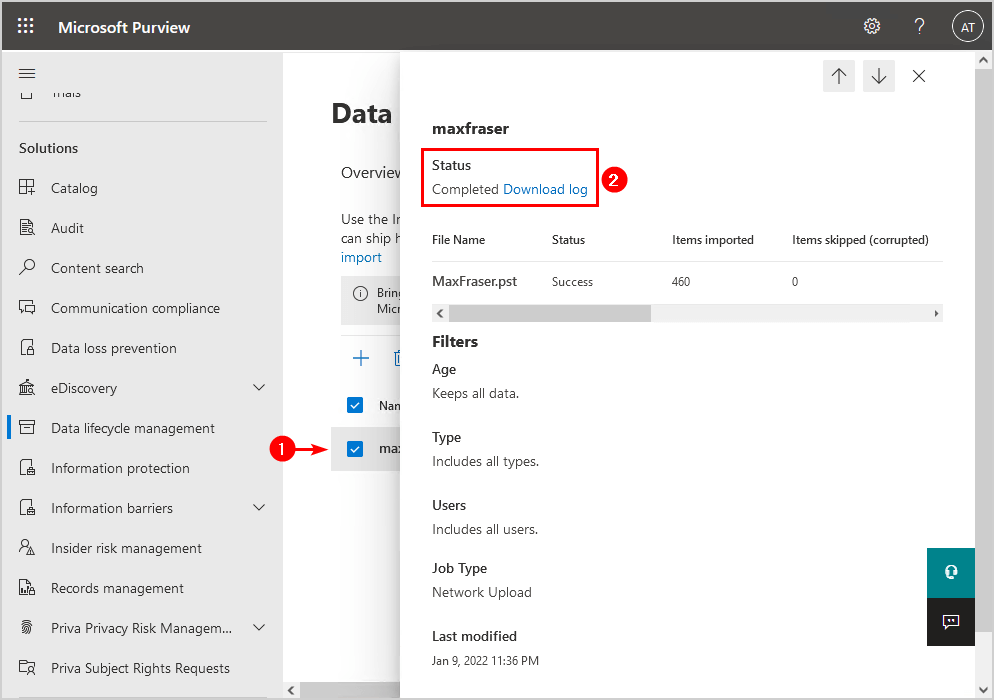
You successfully imported a PST file to Office 365.
Was this article helpful?
That’s Great!
Thank you for your feedback
Sorry! We couldn't be helpful
Thank you for your feedback
Feedback sent
We appreciate your effort and will try to fix the article